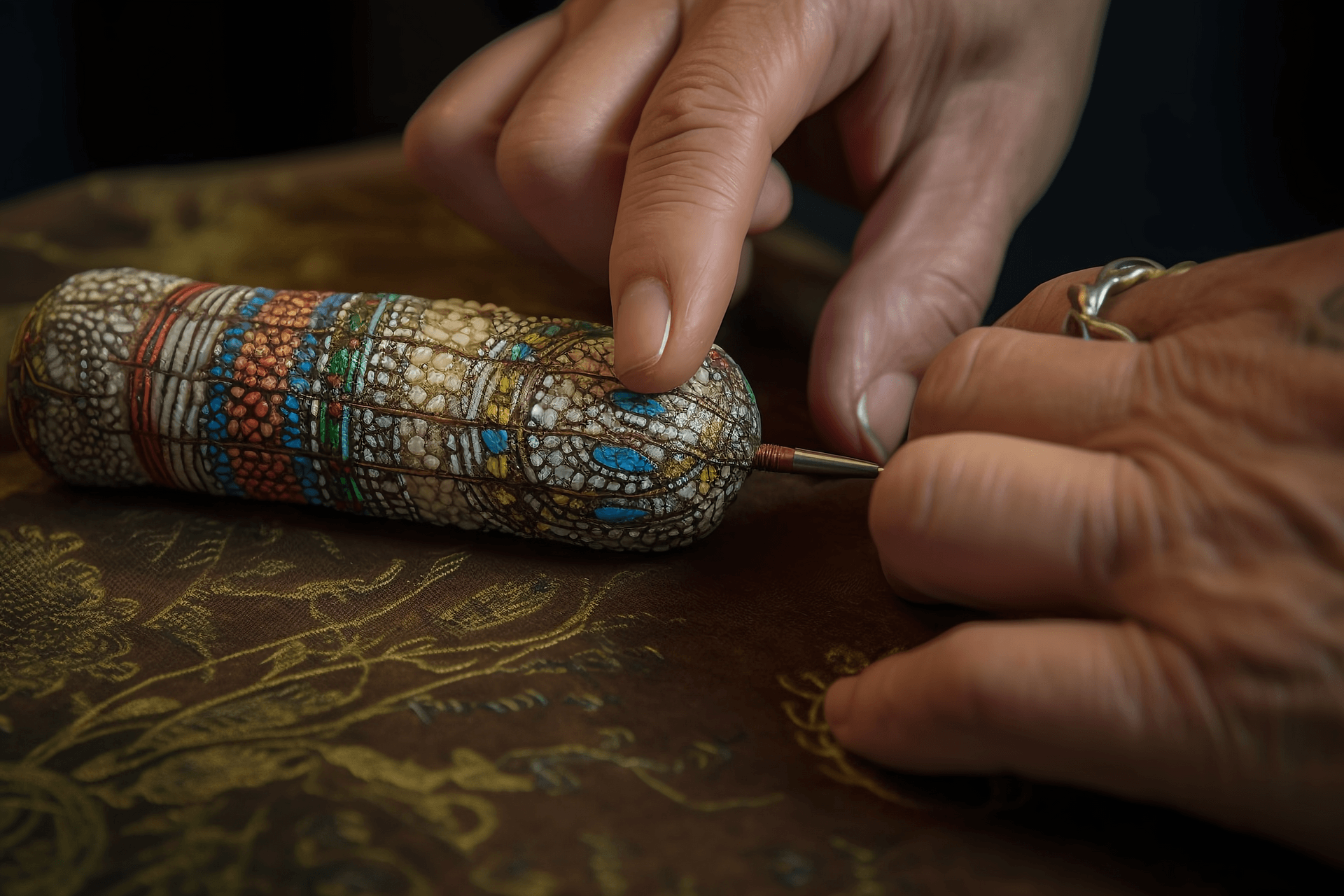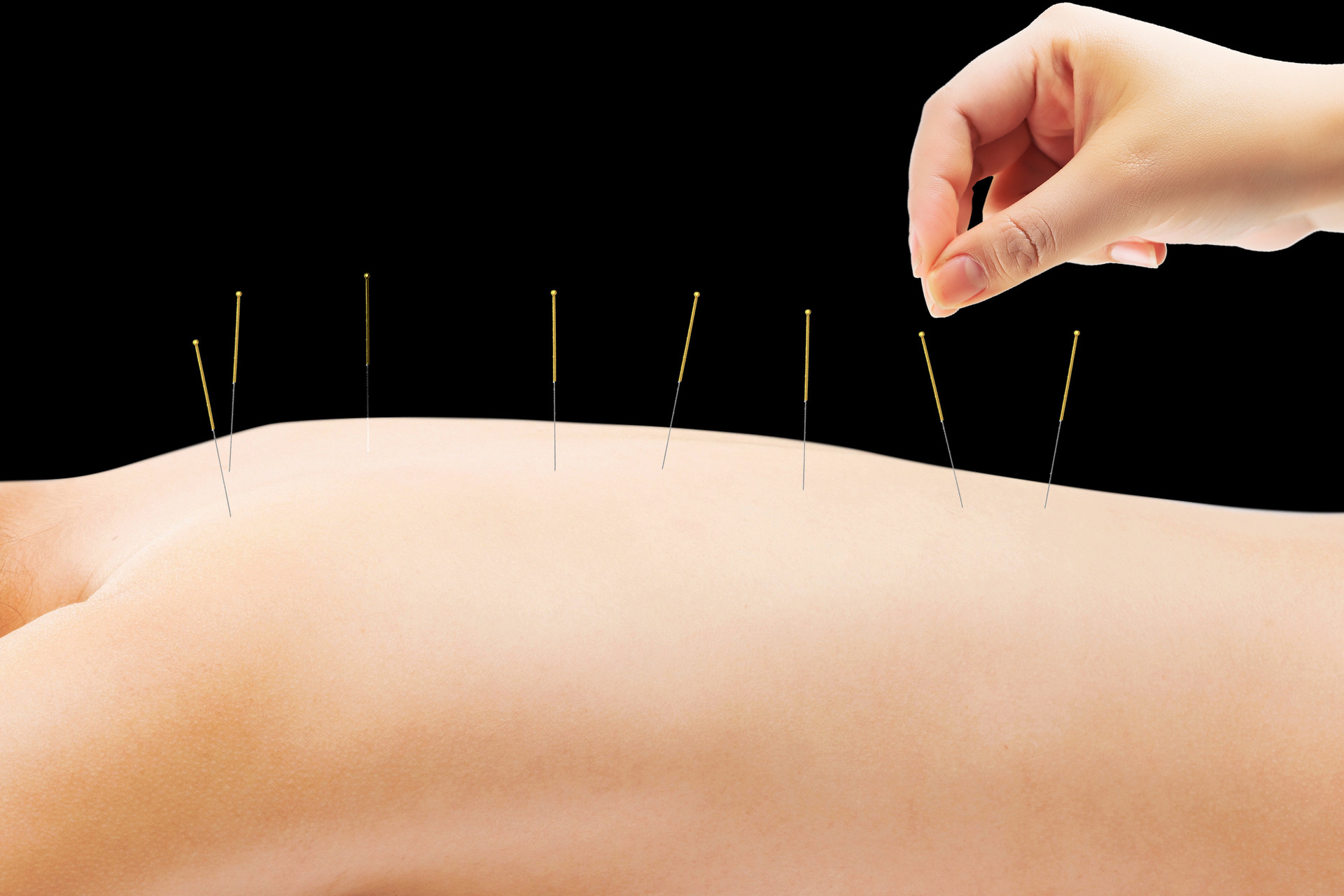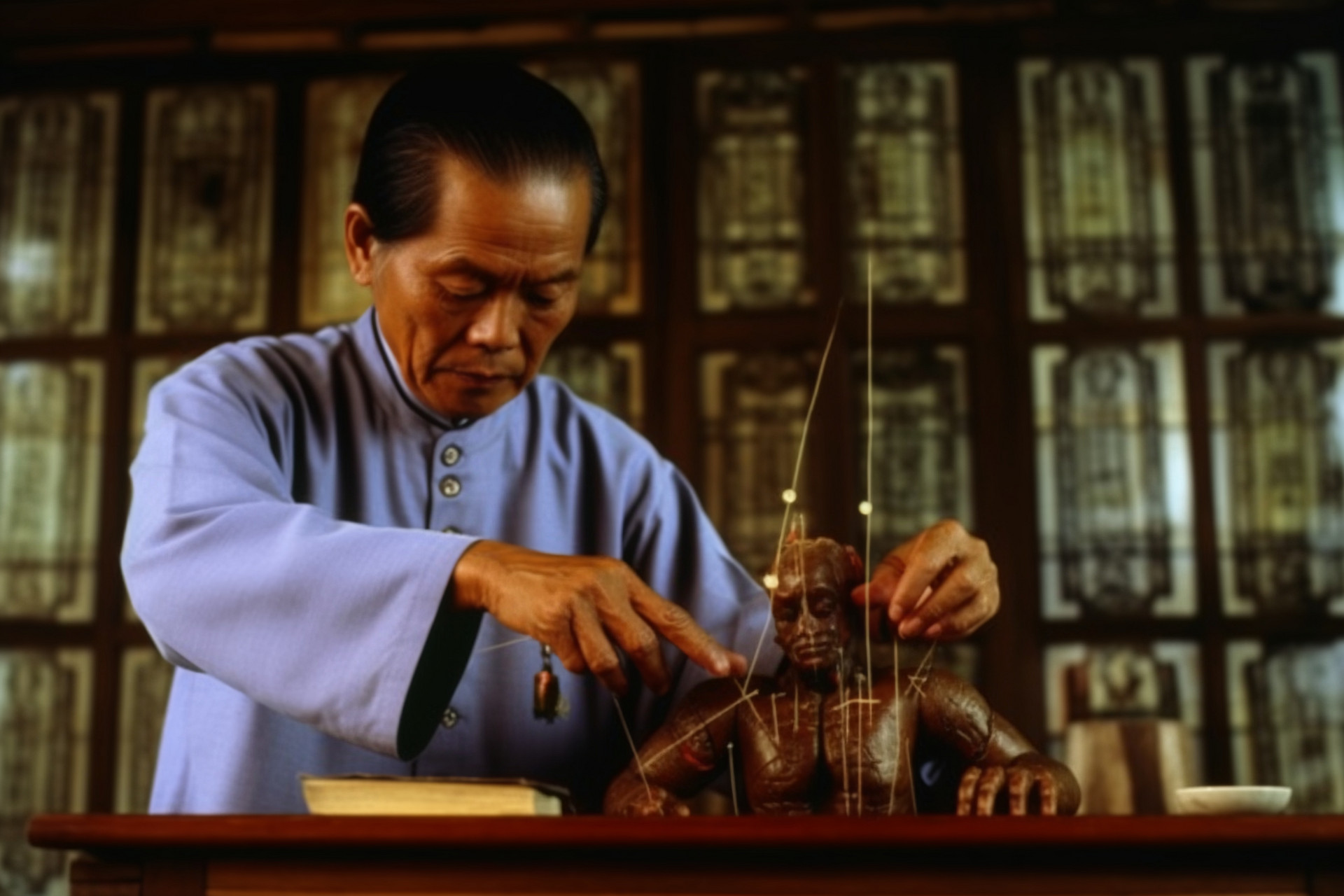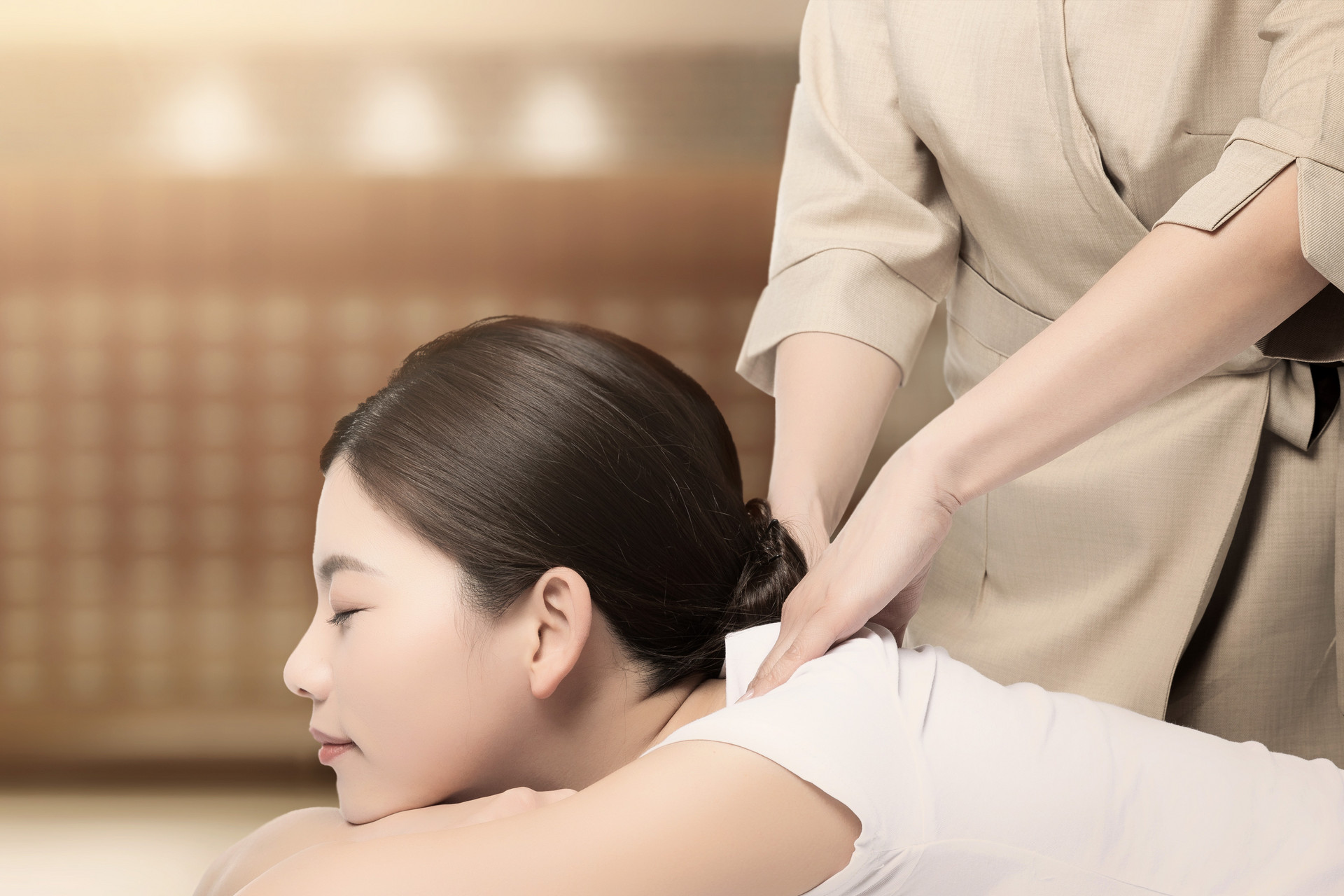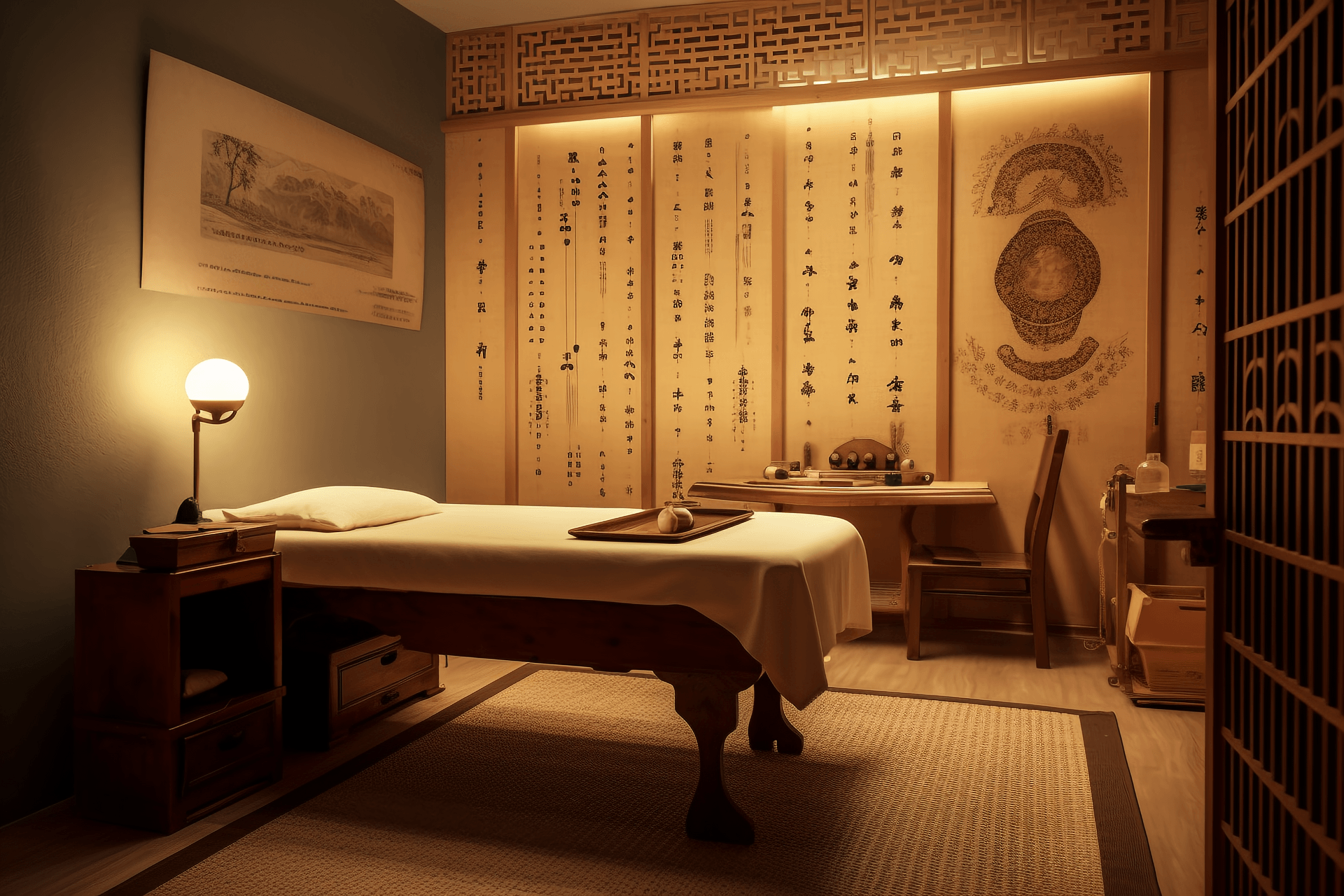
Gu's Three Yin and Three Yang Opening and Closing Diagram

Diagram of Locations
Overview of Longsha Six Qi Acupuncture Method
By Wang Kaijun, Baoji Traditional Chinese Medicine Hospital, Shaanxi
During the process of studying the theory of Five Movements and Six Qi, under the guidance of Professor Gu Zhishan, the representative inheritor of the Longsha medical school recognized by the National Administration of Traditional Chinese Medicine, we discovered that the Taiji diagram of opening and closing can be applied to various parts of the body. Based on the pathogenesis of the Three Yin and Three Yang, we achieved satisfactory therapeutic effects by using acupuncture at the corresponding locations. We named this method the Longsha Six Qi Acupuncture Method.
This therapy fully utilizes the thinking model of the Six Meridians based on the theory of Five Movements and Six Qi. It is simple and easy to operate, with reliable and rapid effects. It has a wide range of clinical applications and can be used for various diseases in internal medicine, surgery, gynecology, pediatrics, etc. It has been repeatedly verified in clinical practice and has strong reproducibility.
Theoretical Foundations
Based on the theory of Yin and Yang convergence in the Huangdi Neijing (Yellow Emperor's Inner Canon), Professor Gu Zhishan creatively depicted the "Gu's Three Yin and Three Yang Opening and Closing Diagram" and the "Gu's Three Yin and Three Yang Taiji Seasonal Diagram", clearly showing the running rhythm of the Six Qi of the Three Yin and Three Yang in the human body. This is the theoretical foundation of the Longsha Six Qi Acupuncture Method.
Acupuncture Key Points
Specific Localization
The Taiji diagram of opening and closing can be created with any point in the human body as the center. In clinical practice, we found that the head is the most effective and practical, and other commonly used locations include the abdomen, sacrum (often used for fire needle), and the affected area.
Position of the Practitioner and Patient
"The sage stands facing south," so both the practitioner and the patient should be in a position facing south, which is the ideal state of correspondence between heaven and human. However, Taiji is a circular movement, and what the practitioner sees is always ascending on the left and descending on the right. The opening and closing of Yin and Yang are in pairs, and we have observed in clinical practice that the two openings of Taiyang and Taiyin are connected, the two pivots of Shaoyang and Shaoyin are connected, and the two closings of Yangming and Jueyin are connected. Therefore, the treatment can be effective regardless of the practitioner's orientation, as long as the general principle of the abdomen representing Yin and the back representing Yang is followed.
Acupuncture Technique of the Practitioner
The practitioner should face the area to be needled and insert the needle along the skin clockwise without deliberate tonifying or reducing techniques. Recently, Professor Gu Zhishan has used finger pressure instead of needle insertion and achieved good results.
Significance and Method of Acupuncture Center Point
The center point guides the needle to the affected area indicated by the pathogenesis and can also be called a meridian-guiding needle.
Acupuncture Based on the Time of the Six Meridians
According to Gu's theory of opening and closing, the time when the six meridians are ready to open is an important basis for judging the pathogenesis.
Number of Acupuncture Points to be Selected
Generally, 2-3 points are selected based on the main and secondary manifestations observed by the practitioner. Other precautions are the same as for general acupuncturists.
Case of Frequent Urination
Ms. Mao, female, 48 years old, had a fall and injured her lower back and left hip on July 10, 2019. She complained of frequent urination, with one episode every half an hour during both day and night, severely affecting her sleep. She received a single treatment with head acupuncture (Taiyin and Taiyang), and she did not wake up for urination that night. After four treatments, she recovered completely.
Analysis: According to the main symptom of frequent urination, the bladder belongs to Taiyang, and being in the earth phase, Taiyin is closely related to the earth. Therefore, Taiyin and Taiyang were selected as the corresponding points, following the natural course of treatment and achieving rapid recovery with the help of the appropriate timing.
Case of Paroxysmal Atrial Fibrillation
By Lin Yirong, Jingjiang Hospital, Jiangsu
Ms. Sun, female, born in August 1952. The patient had been experiencing "palpitations and discomfort, lasting for 3 hours" due to paroxysmal atrial fibrillation on July 24, 2019. The electrocardiogram showed a heart rate of 113 beats per minute, rapid atrial fibrillation, and T-wave changes. After 24 hours of intravenous administration of Cordarone, the heart rhythm was restored, and the patient continued to take Cordarone orally. On the evening of August 2, the patient complained of palpitations and discomfort again. The cardiac monitor indicated rapid atrial fibrillation with a heart rate of 120 beats per minute, a slightly red tip of the tongue, thin white coating, and a thin and rapid pulse.
Acupuncture was performed with three needles at the head's Shaoyin, and an additional needle was inserted at Baihui to penetrate Shaoyin. Several minutes later, the atrial fibrillation converted to normal sinus rhythm, with a heart rate of 86 beats per minute.
The treatment was continued once on August 3. After the treatment, the patient reported no discomfort and was discharged. On August 19, during the follow-up visit, the patient had not experienced another episode of atrial fibrillation.
Analysis: Paroxysmal atrial fibrillation belongs to the Hand Shaoyin heart meridian. Additionally, with the slightly red tongue tip indicating the fire of Shaoyin, and being in the year of Ji Hai, the fourth of the five elements, Shaoyin fire merges with the earth of Taiyin. Therefore, the Shaoyin three needles were selected, and the addition of Baihui effectively treated the supposedly irremediable atrial fibrillation in a few minutes, demonstrating the miracle of this acupuncture technique.
Case of Heel Pain and Breast Hyperplasia
By Zhuo Ying, Xi'an Workers' Hospital, Shaanxi
Ms. Zhang, female, consulted on August 21, 2019. She complained of bilateral heel pain worsened by walking, left breast lump with pain, poor sleep, and easy awakening. Her tongue was pale with a thin white coating, and her pulse was slippery.
Treatment was performed using the Longsha Six Qi Acupuncture Method. Acupuncture was applied at the head's Taiyin, Taiyang, and Shaoyin points. After the treatment, the patient reported immediate relief of heel pain and a significant reduction in the size of the breast lump. The treatment was left in place for half an hour.
During the follow-up visit one week later, the patient reported only mild heel pain, and no obvious breast lump was palpated during the examination. There was no significant pain, and her sleep was excellent. The treatment was continued to consolidate the effect.
Analysis: Heel pain belongs to the Shaoyin Kidney meridian, which also passes through the bladder meridian. Therefore, Taiyang and Shaoyin were selected. Being born in the Ren Yin year, Taiyang's cold water deficiency was considered, and Taiyang was chosen. This year is also the year of Ji Hai, and according to the Jin Kui Yao Lue, when there are liver diseases, it is necessary to consider the spleen as the primary organ. Therefore, the treatment included the addition of the Taiyin point to achieve the effect of invigorating and harmonizing the liver.
Case of Kidney Stones
By Tao Qiulian, Jishengtang TCM Clinic, Jingjiang, Jiangsu
Mr. X, male, 42 years old. He complained of recurrent lower back pain for 16 years. He was diagnosed with bilateral ureteral stones at a tertiary hospital in Shanghai. The latest examination showed sandy stones in the ureters, with the largest stone measuring 13 mm on the left side and 10 mm on the right. On the night of July 24, 2019, he had another episode of severe lower back pain, particularly on the right side. The hospital recommended hospitalization for lithotripsy treatment, but the patient had lost confidence in lithotripsy after multiple unsuccessful attempts and sought treatment at our clinic on July 26. When he came to the clinic on the morning of July 26, he was curled up and unable to stand up straight due to the pain.
According to the patient's disease location in the kidneys and bladder, as well as the influence of the cold water and damp earth from the Ren Yin year, and considering that it was the fourth of the five elements, the year of Ji Hai, which is dominated by the Taiyin damp earth, the Taiyin, Taiyang, and Taiyin points were selected as the center points for acupuncture. The patient felt the sinking of qi in the right lower abdomen after the needles were inserted, and the pain disappeared immediately after the needles were removed. He was able to walk normally and only felt a slight swelling in the lower back. The ultrasound examination three days later showed a significant reduction in the size of the ureteral stones: 8 mm on the left side and 7 mm on the right side. Due to the patient's business trip, acupuncture treatment was not continued. During a follow-up visit, the patient reported no further episodes of lower back pain.
Case of Swallowing Difficulty After Stroke
By Wang Xijun, Zhangdian District Hospital, Zibo, Shandong
Mr. Zhang, male, 87 years old. The patient visited the hospital on August 20, 2019. He complained of difficulty swallowing for more than two months. He had no specific cause for the difficulty but experienced severe discomfort when swallowing water. He had a dull expression, dementia, a pale tongue, thin white coating, and a weak and deep left pulse.
Acupuncture was performed at the head's Taiyin, Shaoyin, and Yangming points, with an emphasis on the Shaoyin point. After 6-7 minutes of treatment, the patient reported a significant reduction in the stiffness of the abdomen and a softening of the abdominal area. After 1 hour and 10 minutes, the patient could swallow and consume 150 ml of liquid independently. The treatment was continued once a week for four weeks. During the follow-up visit, the patient reported normal swallowing function, restored speech function, and improved sleep.
Analysis: According to the analysis of the Six Qi pathogenesis, the patient's left pulse was deep and weak, suggesting a pathogenesis in the Shaoyin meridian. Additionally, since the patient was born in the year of Xin Yin, the wood element was excessive during the year of his birth, and the Shaoyin fire was dominated by the Taiyin damp earth. This year happened to be the year of Ji Hai, when the Shaoyin fire merges with the damp earth of Taiyin. Therefore, the Shaoyin and Taiyin points were selected, and the effect of dispelling the Shaoyin pivot was achieved, resulting in the rapid recovery of swallowing function.
Case of Abnormal Liver Function
By Wu Zhen, Wuxi Hospital of Traditional Chinese Medicine, Jiangsu
Mr. Zhao, male, born in 1992. On July 14, 2019, the patient experienced sudden pain in the left and right ribs at 5:30 am, with a body temperature of 39.0°C. He also had a sore throat, slight stomach pain, dizziness, and nausea. He fell down the stairs. When he came to the hospital, his liver function test showed aspartate aminotransferase (AST) levels of 221.0 U/L and alanine aminotransferase (ALT) levels of 503.0 U/L. The lactate dehydrogenase (LDH) level was 1620.0 U/L. The next day, the levels of these indicators continued to increase, with AST rising to 675.3 U/L. The urine analysis showed proteinuria (+), bilirubinuria (+), microalbuminuria >150.0 mg/L, and creatinineuria 26.4 mmol/L. The patient received acupuncture using the Longsha Six Qi Acupuncture Method, with acupuncture at the head's Shaoyin, Shaoyang, and Taiyin points. After the treatment, the patient reported relief of symptoms, and no medication was administered.
After three days of acupuncture treatment, the liver function test showed AST levels of 225.9 U/L, ALT levels of 47.0 U/L, and LDH levels of 172.3 U/L. The urine analysis showed proteinuria (–), bilirubinuria (–), microalbuminuria 30.0 mg/L, and creatinineuria 8.8 mmol/L. The treatment was continued for four more sessions, and on July 25, the liver function test and urine analysis were all normal (AST decreased to 39.5 U/L, and ALT decreased to 21.2 U/L). No medication was used throughout the treatment process.
Analysis: The patient's symptoms occurred during the Shaoyin and Taiyang pivot times of the Six Qi. The patient was born in the Ren Yin year, and the Taiyang cold water was insufficient. Therefore, Taiyang was selected to stimulate the generation of yang qi. This year is a year of insufficient earth movement, and according to the Jin Kui Yao Lue, when liver diseases are observed, it is necessary to consider the spleen as the primary organ. Therefore, the Taiyin point was added to achieve the effect of invigorating the liver.
Case of Cancer Pain and Difficulty Walking
By Wang Sijun and Deng Lichun, Jingjiang Hospital, Jiangsu
Mr. Lu, male, 79 years old. He was diagnosed with left lung adenocarcinoma with multiple bone metastases. He received pain relief treatment with opioids but still had difficulty walking. During the consultation with Professor Gu Zhishan, acupuncture was performed using the Longsha Six Qi Acupuncture Method, with acupuncture at the head's Taiyang, Shaoyang, and Taiyin points. The patient immediately reported relief of pain in the inner side of the left femur, and after 1 hour, he was able to walk without any difficulty. One week later, during the follow-up visit, the patient reported only mild heel pain, no obvious breast lump, improved sleep, and a good appetite. The treatment was continued to consolidate the effect.
Analysis: Heel pain belongs to the Kidney Shaoyin meridian, which also passes through the bladder meridian. Therefore, Taiyang and Shaoyin were selected. In addition, this year is the year of Ji Hai, and the little sun and little yin are in the spring. Since the patient experienced pain in the morning while walking, it was the time of Shaoyin's resolution, so Shaoyang was also selected.
Case of Severe Menstrual Pain
By Hu Shuzhan, Huayu Town Health Center, Jinxing County, Shandong
On August 22, 2019, during my visit to Professor Gu Zhishan's clinic in Hefei, I suddenly experienced severe menstrual pain in the lower abdomen, making it difficult to bear. I had nausea, vomiting, profuse sweating, and cold, wet skin. After receiving acupuncture treatment at the abdomen's Taiyin and Yangming points and applying hot compresses, there was some improvement, but the abdominal pain persisted. At that moment, Professor Gu Zhishan used the Longsha Six Qi Acupuncture Method, applying finger pressure for about 2 minutes at the head's Taiyin and Yangming points. Immediately, I felt the relaxation of the abdominal muscles and the softening of the abdomen. After 10 minutes, the abdominal pain completely disappeared. I was able to sit next to Professor Gu and take notes again.
Analysis: The Longsha Six Qi Acupuncture Method relies on the understanding of the opening and closing pivot of the Six Qi. Professor Gu Zhishan related the opening and closing pivot theory to women's menstrual cycles. For example, when the menstrual flow is heavy, the Guchong Decoction, which strengthens the spleen and stops bleeding, is used; when the menstrual flow is light, herbs that promote the flow of Yangming are used, such as Ophiopogon and Pinellia. This time, the Longsha Six Qi Acupuncture Method was used to treat dysmenorrhea by applying finger pressure to the Taiyin and Yangming points, achieving remarkable results and confirming the correctness of applying the opening and closing pivot theory to the menstrual cycle.
Case of Blood Sugar Reduction by Finger Pressure
By Zhao Ziyu, Wuxi Hospital of Traditional Chinese Medicine, Jiangsu
On August 23, in the afternoon, I invited Professor Gu Zhishan to consult on rounds in our hospital's classic ward. The patient, Mr. Su, was a 50-year-old man with type 2 diabetes diagnosed a year ago. He was taking metformin and acarbose to control his blood sugar. Two months ago, the patient complained of increased fatigue and came to our clinic for treatment with Chinese herbal medicine. His blood sugar medication was changed to acarbose, and his blood sugar control was poor. Professor Gu used the Longsha Six Qi Acupuncture Method, applying finger pressure to the Taiyin, Shaoyang, and Taiyin points on the head, with a focus on the Shaoyin point. After 1 hour and 10 minutes, the patient's blood sugar level dropped to 6.8 mmol/L. In comparison, the patient's postprandial blood sugar over the previous 5 days ranged from a minimum of 8.9 mmol/L to a maximum of 17.9 mmol/L. The use of the Longsha Six Qi Acupuncture Method significantly reduced the patient's blood sugar, even lower than the fasting blood sugar level during the previous 5 days.
After the consultation, Professor Gu analyzed the patient's condition and prescribed a modified version of the Formula for Regulating the Stomach and Spleen. During the follow-up visit on August 31, the patient's fasting blood sugar level was 7.0 mmol/L, and postprandial blood sugar was 8.7 mmol/L. The blood sugar level had steadily decreased.
Case of Intractable Hyperhidrosis
By Guo Xiangyun, Yankuang Xinlicheng General Hospital, Shandong
Ms. Yang, female, 55 years old, had a history of excessive sweating for many years. The sweating episodes were irregular and worsened after physical activity. Sometimes, she experienced nocturnal sweating. After the sweating subsided, her skin would be cold and wet, alternating with hot flushes. In the morning, she had joint stiffness, fatigue, shortness of breath, difficulty urinating, constipation, and poor sleep, waking up easily at around 3 am and having shallow sleep afterward. Her tongue was pale and swollen with a thick white coating, and her pulse was thin and deep. She had a history of arthritis.
On June 26, 2019, the patient came for consultation and received routine medication for more than a month. Although her symptoms improved, her hyperhidrosis did not improve significantly.
On August 10, acupuncture treatment was performed using the Longsha Six Qi Acupuncture Method, with acupuncture at the head's Taiyang, Shaoyang, and Taiyin points, as well as the Shaoyin point.
The day after acupuncture treatment, the patient reported a slight sweating sensation on the skin, but it quickly subsided. On August 18, the patient reported that the sweating had gradually ceased under normal conditions. Additionally, her joint pain and frequent headaches had also improved.
Analysis: Sweat is the fluid of the heart, which belongs to the Shaoyin. It is also connected with the Taiyang externally and internally. Therefore, the Taiyang and Shaoyin points were primarily selected. This year, the earth movement was insufficient, and the fourth of the five elements, Taiyin damp earth, was dominant. Therefore, the Taiyin point was added. By focusing on the Shaoyin and Shaoyang points, the entire body's qi transformation and circulation were regulated, resulting in the complete cure of symptoms such as headaches and joint pain.
Case of Stiff and Painful Right Thumb
By Chu Zhan, Wuqing Hospital of Traditional Chinese Medicine, Tianjin
On July 25, 2019, I was at Professor Gu Zhishan's clinic in Hefei for further study. I suddenly experienced stiffness and pain in my right thumb, which had persisted for more than a year. The symptoms usually started in the morning and worsened throughout the day. After acupuncture treatment at the head's Taiyin and Shaoyang points for approximately 2 minutes, I felt a significant reduction in pain in my right thumb. In the follow-up visit one week later, I reported that the effect of the treatment remained stable.
Analysis: The patient had loose stools and a thin white coating on the tongue, with a thin and slippery pulse. The symptoms belonged to Taiyin, and this year, the earth movement was insufficient. The fourth of the five elements, Taiyin damp earth, was dominant. Therefore, the Taiyin and Shaoyang points were selected as the center points for treatment, achieving unexpected results.





